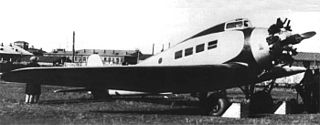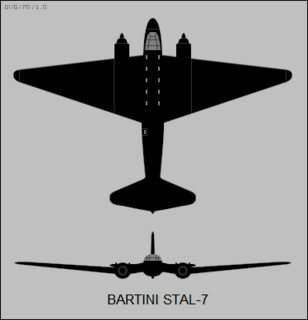
The Tupolev ANT-7, known by the VVS as the Tupolev R-6, was a reconnaissance aircraft and escort fighter of the Soviet Union. The R-6 traces its roots back to early 1928 when the Soviet Air Force needed a long-range multirole aircraft. The requirements were that it could be used for long-range transport, defensive patrolling, reconnaissance, light bombing and torpedo attack.

The Yermolayev Yer-2 was a long-range Soviet medium bomber used during World War II. It was developed from the Bartini Stal-7 prototype airliner before the war. It was used to bomb Berlin from airbases in Estonia after Operation Barbarossa began in 1941. Production was terminated in August 1941 to allow the factory to concentrate on building higher-priority Ilyushin Il-2 ground-attack aircraft, but was restarted at the end of 1943 with new, fuel-efficient, Charomskiy ACh-30B aircraft Diesel engines.

The Yakovlev Yak-2 was a short-range Soviet light bomber/reconnaissance aircraft used during World War II. It was produced in small numbers, and most of them were destroyed during the opening stages of Operation Barbarossa.
The Beriev Be-8, was built by the Soviet Beriev OKB in 1947. It was a passenger/liaison amphibian aircraft with a layout similar to the Be-4 but substantially larger and heavier. It was a single engined parasol winged aircraft, with the wing installed on a thin pylon and a pair of short struts. Compared to the Be-4, the Be-8 was equipped with retractable landing gear, with cockpit and passenger cabins heated by an engine exhaust heat exchanger. The Be-8 was intended as a civil aircraft and carried no armament. First flight was on 3 December 1947, demonstrating good performance and of the two prototypes, one was demonstrated during the 1951 Soviet Aviation Day at Tushino.

The Tupolev ANT-14 Pravda was a Soviet aircraft, which served as the flagship of the Soviet propaganda squadron. It has been credited as Russia's first all-metal aircraft, with a corrosion-resistant-steel structure.

The Tupolev ANT-9 was a Soviet passenger aircraft of the 1930s. It was developed as a reaction to the demand for a domestic airliner. At this time Deruluft, one of the forerunners of Aeroflot, flew only with foreign models, which were mainly German or Dutch.

The Tupolev ANT-25 was a Soviet long-range experimental aircraft which was also tried as a bomber. First constructed in 1933, it was used by the Soviet Union for a number of record-breaking flights.

The Kalinin K-4 was an airliner built in the Soviet Union in the late 1920s which was also adapted for use as a photographic survey aircraft and as an air ambulance. A further development of the K-1, it was a conventional high-wing, strut-braced monoplane with separate enclosed cabin and cockpit. Kalinin undertook the design to offer a locally produced alternative to pioneering Ukrainian airline Ukrvozdukhput, which was at that time flying Dornier designs. The structure was of mixed wood and metal construction, but with major assemblies designed in both wood and metal versions, allowing them to be interchanged. The design also featured a variable-incidence horizontal stabiliser, and the engine mounting was intended to facilitate the ready interchange of different powerplants.

The Kharkiv KhAI-1 (ХАІ-1) was an airliner produced in the Soviet Union in the early 1930s, unusual in that it was designed by students. An exceptionally clean design, the KhAI-1 was the first European passenger transport aircraft to feature retractable undercarriage, and boasted a top speed better than the fighter aircraft in service at the time. Some 40 KhAI-1s were operated by Aeroflot, but while a dedicated military version, the KhAI-1VV was developed and flown in prototype form, this did not enter production.

The Kalinin K-7 was a heavy experimental aircraft designed and tested in the Soviet Union in the early 1930s. It was of unusual configuration, with twin booms and large underwing pods housing fixed landing gear and machine gun turrets. In the passenger version, seats were arranged inside the 2.3-meter thick wings. The airframe was welded from KhMA chrome-molybdenum steel. The original design called for six engines in the wing leading edge, but when the projected loaded weight was exceeded, two more engines were added to the trailing edges of the wing, one right and one left of the central passenger pod. Nemecek states in his book that at first only one further pusher engine was added.

Polikarpov DI-1, also known as 2I-N1, Russian: Поликарпов ДИ-1 (2И-Н1), was a prototype Soviet two-seat fighter designed during the 1920s. The sole prototype built crashed on its ninth flight, due to manufacturing defects, and the program was cancelled.
The RP-318 or RP-318-1 was USSR's first rocket-powered aircraft or Rocket Glider which "RP" stands for in Russian language. Beginning in early 1936 it was first known as RP-218-1 or "Objekt 218" before it was renamed to RP-318-1 in 1938 due to inner reforms of the Rocket Science And Research Institute.

The Tupolev ANT-35 was a 1930s Soviet twin-engined light transport monoplane that entered service with Aeroflot in 1937 as the Tupolev PS-35.
The Nikitin NV-4 was a two-seat amphibious aircraft produced in the USSR in 1936.
The Yakovlev Yak-5 was an experimental trainer aircraft designed by Yakovlev OKB in the Soviet Union, and first flown in 1944.

The Bartini Stal-7 was a twin-engined transport aircraft designed and produced in the Soviet Union from 1934.
The LK-1, , was a four-seat cabin aircraft designed and built in the USSR from 1933.

The Yakovlev AIR-7 was a prototype Soviet high performance light aircraft of the 1930s. It was a two-seat single-engined monoplane, which demonstrated excellent performance during testing. After the prototype almost crashed as a result of flutter, its designer, Alexander Sergeyevich Yakovlev suffered temporary disgrace and no production followed.
The Tupolev ANT-41 was a prototype Soviet twin-engined torpedo-bomber of the 1930s. A single prototype was built, which was destroyed in a crash. No production followed, with the Ilyushin DB-3 serving as a torpedo bomber instead.

The Kalinin K-1, also known as RVZ-6, was a Soviet passenger plane that could carry three people.














